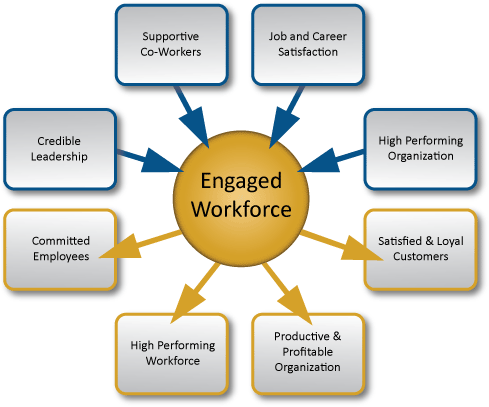Employee attrition rates worldwide are increasing. Of course, not everyone is jumping jobs as one would assume. Your company possibly provides the best working conditions, salaries and perks.
Yet, people will leave.
There are several reasons employees leave a company.
However, the prime cause of attrition is sheer lack of well defined employee engagement policy.

Lack of employee engagement activities negatively affect a business in many areas such as quality, customer relations, teamwork, innovation, morality towards work & company many more.
Employees tend to be more loyal to companies where their services find appreciation. They also look for active participation in company affairs at any level.
If bereft, employees look for the nearest and easiest exit, regardless of their remuneration.
Opinions by topmost management experts for employees
“People work for money. But they go that extra mile for recognition, praise and rewards”- Dale Carnegie.
“Treat your employees exactly as you want them to treat your best customer.” – Stephen R. Covey.
“Most of what we call management consists of making it difficult for people to get their work done.”- Peter F. Drucker.
What is employee engagement ?
Briefly employee engagement can be described as management technique to keep employees happy, well trained and loyal to their organization's goals and values, motivated to contribute to organizational success.
Measuring employee engagement is important, because for increasing performance and sustainable long term growth for company.
It is known to lower employee attrition rates worldwide.
Importance of employee engagement
In light of the above statements, it is clear that employee engagement is vital to succeed in business. Moreover, there are several good reasons why you should strive retain employees.
Firstly, good employees come at hidden cost. Meaning, your company will have invested thousands of precious dollars in man-hours training.
Providing fringe benefits including free coffee or subsidized meals, paid vacation, medical insurance and other perks, also entails expense for your company. Every day given as paid leave is one of these intrinsic expenses.
Not to mention overtime which you might pay to get some work completed.
Further, filling a vacancy is often ponderous. You need to advertize the post, receive and scan applicants, conduct interviews and go through other necessary processes. Once again, the company will spend thousands of dollars on training the incumbent to fit your requirements
Lost expertise, advantage rivals
Furthermore, departing employees pose a subtle yet potent threat to every company. Expertise gained from a company can prove very useful to your competitors.
Additionally, a lost employee will most likely join a rival company, since it will also seek the same set of skills. Equally, sensitive data from your company can fall into hands of competitors.
Of course, you could include a secrecy clause in the contract. However, such clauses are no guarantee that your company secrets are secure.
Benefits of employee engagement
Obviously, these facts prove importance of retaining good employees, especially at senior and sensitive positions.
- Active employee engagement is proven to lower staff attrition.
- Sense of participation enhances overall staff performance.
- High employee performance at all echelon translates as optimum profits.
- Lower attrition means lesser expense on recruitment and training.
- Employee engagement activities keeps all levels of workers happy.
- Participation in company affairs helps generate new, innovative ideas.
- Greater participation by staff leads to better teamwork.
- Engaging employees keeps trade unions at bay.
- Companies with active employee engagement tend to expand rapidly.
- Satisfied employees enhance brand image of the company.
A glimpse into unique employment engagement ideas
Of course, these are purely for your information. Rather, some of these ideas may sound grotesque, depending upon where you reside and work. However, these ideas are actually in practice.
In Finland, female and male staff of a Helsinki based company get together nude- at a spa- every weekend. Going to spas, gym and club on weekends with colleagues is not uncommon but doing it nude definitely is.
Employees of a Thai bank invite their bosses, colleagues and their families to lunch every weekend. The host is decided on rotation basis. Therefore, every staff plays host on some weekend while others can relax completely.
Corporate giants of China have ballrooms in their office. Employees at every echelon can dance with their peers or bosses during break. Some Chinese firms also offer oxygen bars for employees to freshen-up.
Top 20 employee engagement activities
1. Define goals and objectives clearly
Clearly, this requires excellent, lucid communication between all levels of your company’s echelons. However, for some vague reasons, this rarely occurs. Usually, an employee is briefed about her or his duties in the company and given a target.
Sadly, no efforts are made to explain the company’s goals and objectives. Nor are employees told why their services are important to achieve these goals and objectives.
Make every effort to communicate clearly with your employees about the company’s vision and mission, performance and where it wants to go during the current financial year.
Communication channels at all levels of staff should be open. This includes passing, accurate, timely information about any changes in company policies, government regulations, law and order and anything of interest to staff.
Remember, every employee must feel empowered to voice her or his opinion without hindrance or fear.
2. Hold monthly staff meetings
One of the major employee engagement activity is to hold meetings with every member of your staff. Generally, such meetings are held at the end of each month. Ideally, they should be held on the last Friday/ Saturday of the month.
At such meetings, heads of various departments brief all employees about the performance of their respective areas. For example, sales head will talk about targets achieved or missed and detail reasons.
On the other hand, chief of finance will roll out profit and losses during the month and cite causes. Ways and means about improving performance will also figure in such brief presentations.
Usually, such meetings conclude with the company’s top boss summing up the overall performance. The boss also outlines what is required for enhancing performance to achieve targets.
3. Develop excellent corporate culture
Regardless of the size of your company, it is essential to develop a unique, employee friendly corporate culture. It is vital practice for employee engagement.
Basically, corporate culture means the manner in which employees and management interact with one-another, vendors and suppliers, business associates, lenders and investors as well as customers.
Practically, it is somewhat similar to values of a family. Remember, your company relies heavily upon the external world that exists outside the office. A good corporate culture means everyone your employee deals with feels welcome. Their problem may be insolvable.
Yet, they leave the office feeling happy at the treatment by your employees. Some companies include perks for employees or free beverages for visitors as part of their corporate culture.
Others, especially banks and airlines, issue uniforms or implement dress code for all staff. However, this is solely at your discretion.
4. Encourage innovation and creativity
The corporate world is full of stories where some low ranking worker has given ingenuous, workable ideas. These out-of-the-blue ideas from employees have helped companies to attain great heights.
However, these ideas are useless till they are tried and tested. Therefore, the best way to encourage such ideas is to test them within the office or externally, on small scale.
As soon as you know the results after reasonable testing, you can ask employees to modify them.
5. Help employees plan your business
Remember, your employees are the real foot soldiers responsible for success or failure of the company. You may have myriad strategists, management experts, logisticians and motley other experts.
Despite, employees are aware of realities as they exist.
Hence, involving employees in business planning is essential. They can offer a better vision for the company. Further, they will also set realistic, attainable targets rather than vague concepts that never get off the drawing board.
6. Refreshing talents and employee education
Nowadays every skill gets outdated rather quickly. Primarily, this is due to advances in technology and Internet proliferation. To compete in market and gain edge over competitors and peers, it is pertinent to have latest set of skills among all employees.
Ordinarily, most employees will imbibe skills during course of work. Yet, you can conduct refresher courses and educate employees on various topics. These can include technical upgrade, latest market trends and myriad others.
However, it is vital to impart training useful solely for benefit your organization.
7. Create in-house promotion system
Earlier, people got promotions on basis of their tenure with a company. Consequently, inept employees who spent long years at a single desk got promotions. Understandably, this causes discontent among high performers.
You can develop a system for promoting employees that is purely linked with performance. It helps boost staff morale and encourages competitiveness.
In case you do not have a suitable, higher post for a deserving employee, you can upscale her or his grade.
A higher grade entitles the employee to better pay and perks. Unfortunately, hiring newcomers at top positions is a major cause of employees feeling their services are vain.
Remember, age and duration of service are no reasons for promotions. They are humane considerations- nothing more.
8. Promote teamwork and joint projects
Undoubtedly, teamwork is most inexpensive yet highly productive technique for employee engagement.
This can be done at work or play. You can assign a group of employees from various departments to work together on a project that can benefit the company. Alternatively, you can form sports teams of employees.
Playing and working together leaves employees feeling good about the organization they work for. It fosters a sense of friendship and belonging.
Teamwork of any sort breaks cultural and socio-economic barriers. For example, you could have a marketing chief, finance executive, IT expert, driver and salesman working on a project to develop faster product deliveries.
9. Involving employee families at events
Obviously, your employees will spend better part of their day with family. They are directly responsible for joy and welfare of family members.
Understandably, moods, events and occurrences in a family directly impact your employee.
Thus, a ‘family day’ is often useful.
Research worldwide proves that employees develop a sense of belonging to a company that takes care of their family.
Holding celebrations or events including picnics that include family members, goes long way to foster camaraderie and develop loyalty.
It promotes healthy relationships with co-workers. Further, these translate as better working conditions leading to increases in productivity.
10. Rewards program for employees
Nowadays, a common practice of Quick Service Restaurants and other customer centric organizations is to designate ‘Employee of the Month’.
This can be awarded to one or more staff, depending upon the size of your company.
Moreover, having ‘Employee of the Month’ is fairly simple. Staff with exceptional performance during a calendar month gets rewards and recognition.
In addition, their picture, name, designation and other details are displayed on the company notice board.
This program prods other employees into healthy competition. It helps to increase the productivity by employees
11. Use social media for engaging staff
Facebook and Twitter open excellent avenues for employee engagement. Undoubtedly, your company could have a business page on Facebook.
However, making an exclusive one where employees at all levels can interact fosters a sense of friendship and belonging.
Here, you can allow employees to share their personal opinions, views, pictures, experiences and moods. However, you need to ensure that views that conflict with company ideology or hurt religious, political sentiments do not feature here.
A healthy debate on some public issue can be launched among your employees on Facebook.
12. Delegation of authority and duties
Commonly, everyone will vie for promotions and higher pay. However, company owners and top managers face dilemma when it comes to actually handing over a bigger position to someone.
Especially, when there is more than one good contender for a single post.
Delegating duties and responsibilities of a manager to those in lower rungs helps you test their individual capabilities and gray areas. Further, delegation of duties also helps uncover latent and, innate skills of employees.
This is particularly useful in selecting the right person /employee to take higher position.
13. Assist in setting personal goals
Understandably, every employee has personal goals. These objectives cover professional, financial, social and educational growth. Assist your employees to set their personal goals.
It is another good employee engagement activities.
Especially, ask them to set personal goals within realistic, achievable time span. Assisting staff to reach realistic goals will help build immense confidence about future with your company.
Consequently, the ever looming threat of staff attrition will be lowered considerably. On the contrary, employees will strive for the best.
14. Provide touring opportunities
Regardless of the business your company does, you need reach out to customers or suppliers and associates located far away. Therefore, you have ample opportunities to send employees on business trips to distant locations.
Undoubtedly, working away from home for a few days or weeks gives employees the much needed break from routine. Further, it provides them opportunities to develop and test individual skills independently.
15. Interest free loans for genuine purposes
Remember, your employees are human and will have worldly problems. Some of these can be solved easily by providing financial assistance.
Moreover, monetary help in dire emergencies including sickness, death of kin or family tragedy attracts appreciation from employees. They will be grateful for the help, remain loyal and work better.
In addition, offering interest-free loans to fund education of employees’ children or seed money to buy a new house or vehicle also get wide appreciation.
However, you need to hedge interest-free loans against an employee’s future earnings and other benefits. Unfortunately, such loans can tempt people to borrow without real need.
Hence, you need to be cautious about such largesse.
6. Maintain transparency at every level
Understandably, this can sound forbidding for many employers. However, it is vital that your company maintains transparency at all levels, departments and top management. This means, any staff complaints have to reach the proper authority.
Further, steps taken to address grievances are known to all employees.
Notably, this is a very important feature of employee engagement activity. Especially, such transparency is useful while dealing with cases of sexual harassment at workplace, discrimination of any sort or other sensitive issues that have legal dimensions.
Remember, your company’s reputation is at stake if any such cases go to cops or land at courts.
17. Appoint a staff ombudsman
While on the issue of resolving staff complaints, you can appoint a staff ombudsman. Generally, this function is taken by trade unions and their leaders.
Understandably, it is best to speak least about capabilities and fairness exhibited by trade unions.
In such scenarios, it is best to appoint a staff ombudsman. The post should be voluntary and rotated on regular basis- say three months. Hence, complaints of any sort from staff can be referred to this ombudsman.
She or he can interact with concerned department to resolve the issue to satisfaction of both parties. This system is very effective in dealing with minor, everyday office squabbles.
18. Sending weekly newsletter/ company magazine
Regardless the size of your company, newsletters and company magazines are very effective employee engagement activity. Thanks to advances in computer technology and Internet, these newsletters can be made with minimal cost and effort.
Weekly newsletters are simple emails send at the end of every week. They carry company news and achievements or issues encountered during a week. Personal achievements of staff can be highlighted here.
Printed monthly in-house magazines go a step further. They draw employees into a large community through common readership.
19. Common workplace dining facilities
Interestingly, several multinational companies have workplace dining rooms where everyone from top management to low rung workers visit daily. Allot fixed timings for use of the dining room.
Additionally, you may outsource a catering operator to provide reasonably priced or subsidized meals for staff.
Dining rooms serve as ideal locations for all levels of staff to meet and exchange news and views. They help bridge the much needed gap between top management and lower strata employees. Dining rooms provide casual ambience ideal for exchange of ideas.
20. Carrot and stick method
Perhaps this is what most employees want and love. Carrot and stick simply means performance linked salary hikes and incentives. Everyone works for money. People will exert extra efforts when they are sure to be rewarded.
However, to do so, you need to ensure complete transparency in the increment, incentives and promotion process. This transparency is vital to ensure there is no disenchantment over somebody getting paid more as others feel left out.
The expert sums it up
“When employees are happy, they are your best ambassadors.”- James Sinegal. This quote by the former CEO of retail giant Costco, aptly describes why you should opt for employee engagement programs.
It is quite clear that today, companies must take creative initiatives to boost employee engagement. and also correct work allocations with real timeline, encouraging balance work life, promoting employee wellness, bringing positive working culture.










